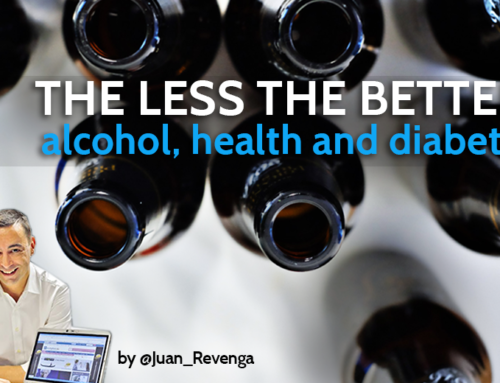Findrisc: eight questions to know my risk for type 2 diabetes
In most cases, each person has the possibility to get rid of the risk of type 2 diabetes, or at least an important delay its debut.
There are burning issues that help us focus on this risk in order to be warned and be able to deal with it with the best lifestyle strategies (including adequate food).
Type 2 diabetes is a pathology in which lifestyles have a lot to say. In any case, it should always be kept in mind that there are also factors that cannot be changed, such as gender, age or genetic predisposition. At the same time, there are many other factors that can be modified and that can significantly reduce the risk of suffering this important metabolic disease that threatens to become, if it is not already, one of the major epidemics of the 21st century. Briefly said, between 7 and 8 out of 10 cases of type 2 diabetes could be avoided by following appropriate lifestyles, including healthy diet and proper physical activity. For you to get an idea, according to the International Diabetes Federation (IDF) it is estimated that in 2014 there were 387 million people in the world with diabetes, and the predictions for 2035 are the planet will have 592 million patients with this disease. The main causes for this spectacular increasing, knowing that a century ago this medical condition was considered little less than a rarity, have focused mainly on pointing to both the deterioration of the diet (quantitatively and qualitatively speaking) and the dramatic decrease in physical activity, a prominent feature of first world societies.
Before this happens, as can be seen from the said above, we have much room for maneuver on the issue of diabetes. Thus, from a series of simple tools that make available to us some of the most prestigious scientific societies in this field we can have in advance an idea of what our risk of type 2 diabetes is. Such is the case of this mini questionnaire that Can be downloaded here and has already been validated and used on the ground systematically to assess the risk of the population suffering from diabetes 2 soon. Having a tangible result will serve to implement therapeutic and preventive measures. An example of what I am telling you is found in Finland, a pioneer country in establishing the Developmental Program for the Prevention and Care of Diabetes (DEHKO).
Obtaining a valid reading of the risk of type 2 diabetes in the next 10 years is as easy as answering those 8 relatively simple questions, adding up the number of points corresponding to our response, and reading the result by the score.
The questionnaire I am talking about tackles 8 key issues that will determine the risk. Let see them one by one:
1. Age
One of those elements that are not modifiable since we have the age that we have, and we cannot do anything to change it. This variable is important if we consider that until not too long ago, type 2 diabetes was colloquially known as “adult diabetes”. A clear distinction to type 1 diabetes (marked with a big genetic component). In fact, this nomenclature (“adult diabetes”) has fallen into disuse as it has been verified for a few decades that both a significant fraction of the children and young people already have a series of metabolic markers associated with diabetes, this pathology Is no longer unique heritage “of the adult”. Causes, as you can imagine, are aware that those habits of life particularly unbalanced in relation to the poor quality of diet and poor physical activity can make a dent in the most “virgin” metabolisms, and have sooner repercussion in the form of insulin resistance and diabetes … something that, as I say, was only arrived at after a more prolonged exposure to these bad habits. Let say that, somehow, the process has been accelerated and what used to only happen mostly in the adult population, is now reflected in earlier ages. Anyway, age remains a key element for type 2 diabetes debut, the older you get the bigger the risk. Hence its presence in the questionnaire.
2. Weight
The second question focuses on the individual’s weight. It uses one of the most common tools: Body Mass Index (BMI) to relate height to weight.
The number obtained, the index, is ordered in a scale that suggests the situation of the patient classifying in low-weight, normal-weight, overweight or obesity. Regardless of the excess weight understood as the excessive accumulation of fat, it is intimately related to the metabolic syndrome, a group of five factors of risk (High blood pressure, high blood glucose, high triglycerides, low levels of HDL or “good” cholesterol, and excess abdominal fat). Which as can be intuited with a naked eye, is closely related to the risk of developing type 2 diabetes
3. Metabolic syndrome factors: waist circumference?
In the third question, one of these factors of the so-called metabolic syndrome (sometimes referred to as syndrome X) is recalled, in this case the perimeter of the waist since it is considered that the greater the perimeter, the greater the probability of having an excess of abdominal fat, another of the predisposing factors for type 2 diabetes. This variable is divided by genders. Because of their different physical constitution, men and women have different cut points when classifying their abdominal perimeter and, therefore, the amount of fat in this anatomical region. The greater the perimeter, the greater the amount of central fat and thus the greater the likelihood the probability to develop type 2 diabetes.
 4. Physical activity?
4. Physical activity?
The fourth question focuses on the pattern of physical activity. We have quite well contrasted that people with levels of physical activity considered as sedentary have a poorer metabolic management of the level of blood glucose, as well as that of insulin. In this way, we understand the importance of this issue: the more sedentary lifestyle, the worse the prognosis for type 2 diabetes, and therefore, the worse “score” in the questionnaire.
5. Bad nutritional habits?
In the fifth question comes the diet issue, uniquely focused on the consumption of foods of fresh vegetable origin (fruits and vegetables). This type of food present in the diet usually offers two benefits: on one hand imply better management of all the nutrients present in the diet, especially carbohydrates (At the time of presenting an interesting nutritional profile rich in antioxidants, vitamins, minerals and fiber). On the other hand, its mere presence implies a greater probability of displacing other foods less advisable. If you eat the right fruits and vegetables, you are less likely to consume less recommended or directly harmful foods in the form of processed products, rich in sugars, unsuitable fats, and so on. As you can imagine, the lower frequency of fresh vegetable foods in your diet, worse note and therefore, higher risk of type 2 diabetes.
6. Medication?
Question number six asks us if we are taking medication for arterial hypertension, the reason we can find it knowing that both circumstances (Diabetes and hypertension) are usually associated. This relationship cannot be explained from chance since for both diseases there are common mechanisms. In fact, it is estimated that 40 to 60% of people with diabetes suffer at the same time hypertension. In addition, if you realize, hypertension is one of those burning items included in the metabolic syndrome. So, if you have hypertension, you are at increased risk for type 2 diabetes, plus the addition that hypertension worsens the picture of diabetes especially on the cardiovascular system, that it has been confirmed in people with both pathologies a higher prevalence of myocardial infarctions, renal failure, cerebrovascular accidents (thrombosis), etc.
7. Previous episodes of hyperglycemia: prediabetes or gestational diabetes?
Next, in the seventh question, is valued if there has been previous episode of hyperglycemia, whether punctual or temporary, is a predictive symptom of possible diabetes. This section takes special relevance in the case of women who have been pregnant, to test whether during this period they suffered from gestational diabetes, a parameter that is usually present in all protocols during pregnancy. It is well contrasted that women with gestational diabetes are more likely to develop type 2 diabetes.
Pregnancies aside, males may also have had some “notice” of high glycaemia and hence this question. As it is logical to think, in the face of episodes of periodic or hyperglycemic episodes, greater risk of leading to type 2 diabetes.
8. Genetic predisposition?
Lastly, in question number eight it is to inquire very briefly about genetic predisposition, asking about the family history of diabetes. Besides, in good logic, being closer to blood relatives with type 2 diabetes, the greater the likelihood of developing it.
Irrespective of the result obtained, and to more accurately specify the risk of type 2 diabetes, focusing on genetic issues, there are laboratory tests for risk assessment and treatment, based on the Genomics and personalization of the medicine that, from simple tests, focus their results on the genetic predisposition to suffer type 2 diabetes (An aspect that the questionnaires can only deal superficially). These are Patia’s diabetes prevention projects, such as Diabetes Prevent, which are endorsed by a scientific committee with a long history and extensive experience in the field of diabetes prevention and treatment.
Once we are focused on the main topic, and to bring users the best information available on food, in the next post of this blog we will make an exhaustive review of the most relevant recommendations and dietary aspects in this regard. The importance of body weight, the general structure of diet, healthy habits, planning of different intakes, approaching special events… will be the central topic of these post. As a first step, mention should be made of the fact that these recommendations will focus on the daily and appropriate use of fresh vegetable foods (vegetables, fruits, etc.), naturally rich in fiber (foods made from whole grains, pulses, nuts …) And those that are a source of healthy proteins (eggs, lean meats, fish …). At the same time, that healthy eating pattern will be characterized by a minimal inclusion of processed foods, rich in added sugars and refined starches.
I wait for you in this corner to periodically find out how to remove the danger of type 2 diabetes. Always keeping in mind that what is good for you is good against diabetes and other metabolic diseases.
Juan Revenga, Dietitian-nutritionist.
(foto: Gonzalo Bullón)
Latest posts by Juan Revenga Frauca (see all)
- Obesity recognized as a chronic disease - 13 October, 2021
- Who said you have to eat everything? - 7 October, 2021
- Diabetes and Alzheimer - 29 January, 2021




 4. Physical activity?
4. Physical activity?



